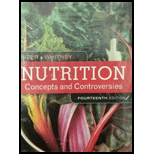
Bundle: Nutrition: Concepts and Controversies, Loose-leaf Version, 14th + LMS Integrated for MindTap Nutrition, 1 term (6 months) Printed Access Card
14th Edition
ISBN: 9781337127547
Author: Frances Sizer, Ellie Whitney
Publisher: Cengage Learning
expand_more
expand_more
format_list_bulleted
Concept explainers
Question
Chapter 9, Problem 2SC
Summary Introduction
Interpretation:
Today estimated 69% of adults in the United States are overweight or obese. Is the statement true or false?
Concept Introduction:
It is true that nationwide roughly two or three of US adults are overweight. Statistics reveals that about 69% of American adult population is obese. The Non-Hispanic black, Hispanic, and Mexican American adults are more obese that Non-Hispanic white adults.
Expert Solution & Answer
Want to see the full answer?
Check out a sample textbook solution
Chapter 9 Solutions
Bundle: Nutrition: Concepts and Controversies, Loose-leaf Version, 14th + LMS Integrated for MindTap Nutrition, 1 term (6 months) Printed Access Card
Ch. 9 - Prob. 1RQCh. 9 - Prob. 2RQCh. 9 - Prob. 3RQCh. 9 - Prob. 1CTCh. 9 - Prob. 2CTCh. 9 - Prob. 1SCCh. 9 - Prob. 2SCCh. 9 - Prob. 3SCCh. 9 - Prob. 4SCCh. 9 - Prob. 5SC
Ch. 9 - Prob. 6SCCh. 9 - Prob. 7SCCh. 9 - Prob. 8SCCh. 9 - When the brain receives signals that enough food...Ch. 9 - Prob. 10SCCh. 9 - Prob. 11SCCh. 9 - Prob. 12SCCh. 9 - Prob. 13SCCh. 9 - Prob. 14SCCh. 9 - Prob. 15SCCh. 9 - Prob. 16SCCh. 9 - Prob. 17SCCh. 9 - Prob. 18SCCh. 9 - Prob. 19SCCh. 9 - Prob. 20SCCh. 9 - Prob. 21SC
Knowledge Booster
Learn more about
Need a deep-dive on the concept behind this application? Look no further. Learn more about this topic, health-nutrition and related others by exploring similar questions and additional content below.Similar questions
- Discuss why obesity is a growing epidemic.arrow_forwardWhen a child has a chronic condition that limits activity, such as spina bifida, what is the greatest long-term nutrition concern? a. Protein limiting growth b. Modified food textures to avoid eating difficulties c. Excessive calorie intake further limiting mobility d. Intake of calcium and vitamin D to prevent bone fracturesarrow_forward
Recommended textbooks for you
- Lifetime Physical Fitness & WellnessHealth & NutritionISBN:9781337677509Author:HOEGERPublisher:Cengage
 Nutrition Through The Life CycleHealth & NutritionISBN:9781337919333Author:Brown, Judith E.Publisher:Cengage Learning,Nutritional Sciences: From Fundamentals to Food, ...Health & NutritionISBN:9781337486415Author:McGuirePublisher:Cengage
Nutrition Through The Life CycleHealth & NutritionISBN:9781337919333Author:Brown, Judith E.Publisher:Cengage Learning,Nutritional Sciences: From Fundamentals to Food, ...Health & NutritionISBN:9781337486415Author:McGuirePublisher:Cengage



Lifetime Physical Fitness & Wellness
Health & Nutrition
ISBN:9781337677509
Author:HOEGER
Publisher:Cengage


Nutrition Through The Life Cycle
Health & Nutrition
ISBN:9781337919333
Author:Brown, Judith E.
Publisher:Cengage Learning,

Nutritional Sciences: From Fundamentals to Food, ...
Health & Nutrition
ISBN:9781337486415
Author:McGuire
Publisher:Cengage